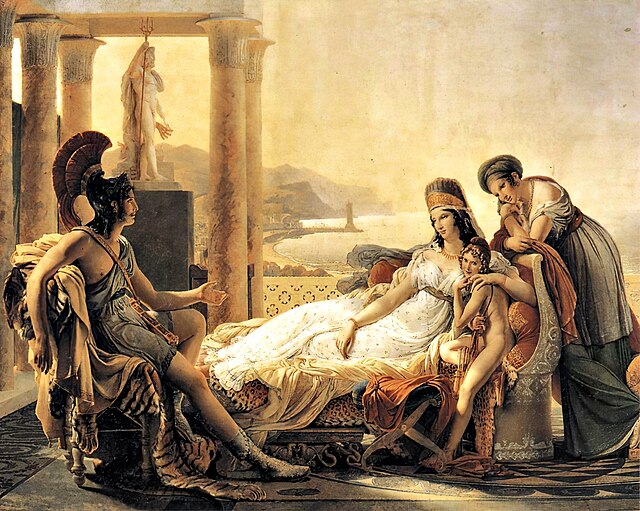Dido, also known as Elissa, was the legendary founder and first queen of the Phoenician city-state of Carthage, in 814 BC.
In most accounts, she was the queen of the Phoenician city-state of Tyre who fled tyranny to found her own city in northwest Africa.
Known only through ancient Greek and Roman sources, all of which were written well after Carthage's founding, her historicity remains uncertain. The oldest references to Dido are attributed to Timaeus, who was active around 300 BC, about five centuries after the date given for the foundation of Carthage.
The Trojan hero Aeneas tells Dido of the Trojan War (Guérin, 1815). In the Aeneid Dido falls in love with Aeneas and is heartbroken when he leaves.
Dido, a painting by Dosso Dossi.
Aeneid, Book IV, Death of Dido. From the Vergilius Vaticanus (Vatican Library, Cod. Vat. lat. 3225).
Dido and Aeneas, from a Roman fresco, Pompeian Third Style (10 BC – 45 AD), Pompeii, Italy
Phoenicia, or Phœnicia, was an ancient Semitic thalassocratic civilization originating in the coastal strip of the Levant region of the eastern Mediterranean, primarily located in modern Lebanon. The territory of the Phoenicians expanded and contracted throughout history, with the core of their culture stretching from Arwad in modern Syria to Mount Carmel in modern Israel covering the entire coast of modern Lebanon. Beyond their homeland, the Phoenicians extended through trade and colonization throughout the Mediterranean, from Cyprus to the Iberian Peninsula.
Two bronze fragments from an Assyrian palace gate depicting the collection of tribute from the Phoenician cities of Tyre and Sidon (859–824 BC). British Museum.
Phoenicians build pontoon bridges for Xerxes I of Persia during the second Persian invasion of Greece in 480 BC (1915 drawing by A. C. Weatherstone).
Achaemenid-era coin of Abdashtart I of Sidon, who is seen at the back of the chariot, behind the Persian King.
A naval action during Alexander the Great's Siege of Tyre (332 BC). Drawing by André Castaigne, 1888–89.








